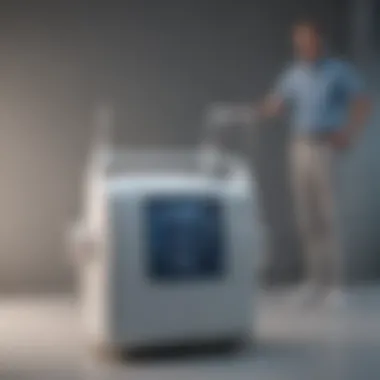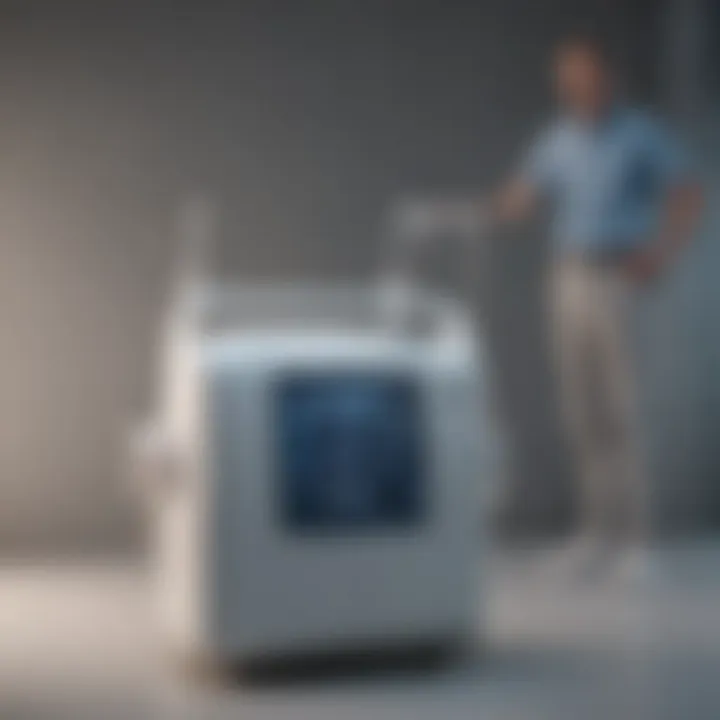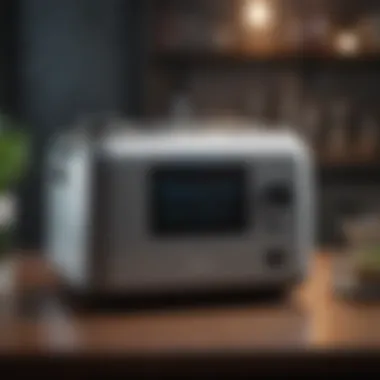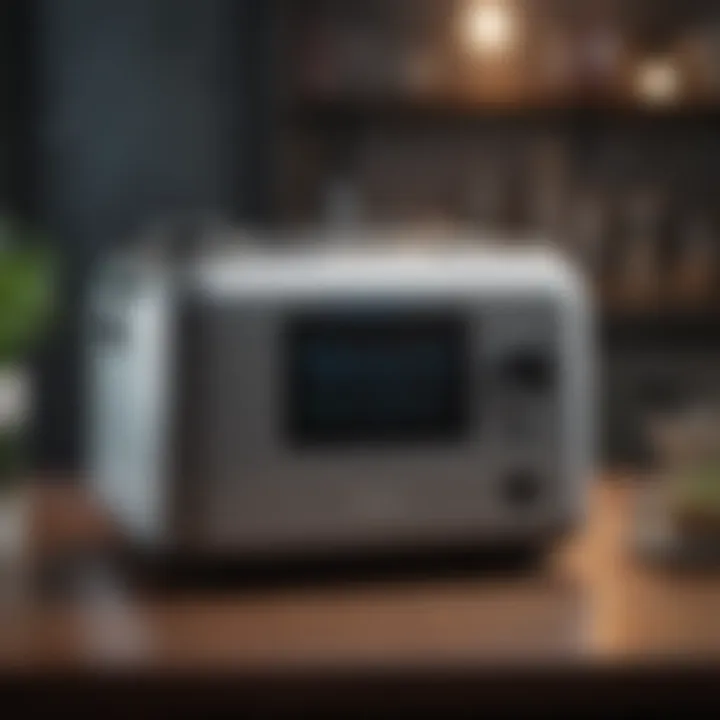Optimal Oxygen Concentrators: Insights & Innovations


Intro
In the realm of respiratory care, oxygen concentrators play a crucial role in improving the quality of life for individuals with various pulmonary disorders. These devices extract oxygen from ambient air, delivering concentrated oxygen to patients who need it. The increasing demand for oxygen therapy has led to significant advancements in the technology and design of oxygen concentrators. This article seeks to unpack the fundamental concepts, mechanisms, applications, and implications of optimal oxygen concentrators.
Understanding oxygen concentrators requires familiarity with some key concepts and terminology. This understanding forms the basis for appreciating how these devices function and their impact on healthcare. Therefore, it is essential to define the terms commonly associated with oxygen therapy and concentrate on the ideas that underpin their use in modern medicine.
Understanding Oxygen Concentrators
The understanding of oxygen concentrators is crucial in today's healthcare landscape, as they play a significant role in managing respiratory conditions. An oxygen concentrator is a medical device designed to provide supplemental oxygen to individuals who have low levels of oxygen in their blood. This section delves into the definition and purpose of oxygen concentrators, as well as their historical development, to provide a foundational knowledge base for readers.
Definition and Purpose
An oxygen concentrator works by taking in ambient air, removing nitrogen, and delivering concentrated oxygen to the user. These devices are vital for patients with chronic respiratory diseases such as Chronic Obstructive Pulmonary Disease (COPD) or asthma. The purpose of using an oxygen concentrator includes enhancing the quality of life, improving oxygen saturation levels, and, ultimately, prolonging life in cases of severe respiratory insufficiency. This device helps in maintaining a stable oxygen supply, which is essential for cellular function and overall body health.
History of Oxygen Concentrator Development
The development of oxygen concentrators began in the mid-20th century. Early models were bulky and less efficient than today's versions. The introduction of pressure swing adsorption (PSA) technology in the late 20th century marked a significant advancement. PSA technology allowed for the filtration of nitrogen from the air, resulting in a more effective concentration of oxygen. This innovation led to the creation of portable models that greatly improved mobility for patients requiring supplemental oxygen.
Further advancements in technology, such as membrane separation methods, have also influenced the design and function of modern concentrators. Today, oxygen concentrators are more compact, lighter, and offer greater oxygen flow rates compared to their predecessors. This evolution reflects the ongoing commitment to improving patient care in respiratory health.
Principle of Operation
Understanding the principle of operation is crucial to comprehending how oxygen concentrators function effectively. This section provides insight into the core mechanisms that allow these devices to separate and deliver oxygen.
Separation of Oxygen
The separation of oxygen from ambient air is the fundamental process behind every oxygen concentrator. In simple terms, this process involves removing nitrogen, which constitutes around 78% of the air we breathe, to increase the oxygen concentration delivered to the user.
This separation can be achieved using various technologies. The first notable method is pressure swing adsorption (PSA). In this process, the ambient air is passed through a sieve material that selectively traps nitrogen molecules while allowing oxygen to flow freely. This method is efficient and widely used in both portable and stationary oxygen concentrators. Another method is membrane separation. It relies on special membranes that allow oxygen to pass through while blocking nitrogen.
Types of Technologies Used
PSA Technology
Pressure swing adsorption technology is a leading technique in oxygen concentration. This technology involves cycles of pressurization and depressurization to separate oxygen from nitrogen. A key characteristic of PSA is its ability to deliver high purity oxygen, usually in the range of 90% to 95%.
PSA technology is popular because it is reliable and efficient. The ability to provide continuous oxygen supply is essential for patients with chronic respiratory conditions. The unique feature of PSA is its low energy requirement compared to other methods, making it cost-effective.
However, PSA systems may occupy more space and have higher maintenance needs. This dual aspect of their design merits careful consideration while evaluating oxygen concentrators for personal or clinical use.
Membrane Separation
Membrane separation technology presents another method through which oxygen concentrators operate. This process uses selective membranes that allow oxygen molecules to move faster than nitrogen molecules. The design is simpler and more compact than PSA.
The main benefit of membrane separation is its small footprint, making it suitable for portable units. This can greatly enhance mobility for users. A unique feature of this technology is that it does not require pressure swings, leading to quieter operation.
On the downside, the purity of oxygen produced by membrane systems is typically lower than that achieved by PSA technology. Users need to be aware of this characteristic as it can impact the effectiveness for patients with specific oxygen needs.
"Oxygen concentrators rely on advanced technologies to meet the varying needs of patients, each with its specific benefits and limitations."
Through these discussions, it becomes evident that the principles of operation in oxygen concentrators are pivotal in ensuring effectiveness, efficiency, and user satisfaction. Carefully selecting the appropriate technology based on the user's requirements is essential.
Types of Oxygen Concentrators
The classification of oxygen concentrators is essential to understand, as it directly influences the selection process for users based on their specific needs. The two main categories are portable and stationary concentrators. Each type presents distinct features, benefits, and considerations, thereby offering a tailored option for various user lifestyles and medical requirements.
Portable Oxygen Concentrators


Portable oxygen concentrators (POCs) are designed for individuals who need mobility and flexibility in their oxygen therapy. These devices are lightweight and compact, making them suitable for travel and daily activities. Patients who travel frequently or have active lifestyles often prefer POCs for their ease of use and convenience.
Some key benefits and features of portable oxygen concentrators include:
- Mobility: POCs are built for easy transport, often featuring carrying straps or wheels. Users can take them on flights, road trips, or simply to the park.
- Battery Options: Many models offer interchangeable batteries, allowing users to extend their usage time without needing to be tethered to a wall outlet.
- Real-Time Monitoring: They often have technology to track oxygen levels and battery status, providing users with critical information on their therapy.
However, it is vital to consider some limitations as well. POCs may have lower flow rates than stationary units and can be pricier. Moreover, the user must understand their oxygen requirements to select a POC that delivers the necessary flow rate.
Stationary Oxygen Concentrators
Stationary oxygen concentrators are typically larger and designed to be used in a fixed location, such as the home or a healthcare facility. These devices can provide a continuous supply of oxygen at higher flow rates than most portable units. They cater primarily to patients who require long-term oxygen therapy and do not require mobility.
The advantages of stationary oxygen concentrators include:
- Higher Output: These devices are capable of delivering higher volumes of oxygen, which might be needed for patients with severe respiratory conditions.
- Cost-Effective: Stationary units generally have lower operational costs over time, particularly for users needing considerable oxygen all day.
- Durability: Built to last, these concentrators can often operate for many hours without issues, providing a reliable oxygen supply.
Nonetheless, users should be aware of potential downsides, such as their size and lack of portability. Stationary units also need to be plugged into a power socket, which may limit their use depending on the location.
The choice between portable and stationary oxygen concentrators fundamentally depends on the individual’s lifestyle and medical requirements. Evaluating these factors is crucial to ensuring that users get the most suitable device for their healthcare needs.
Key Features of Optimal Models
In this section, it is essential to outline the key features that define optimal oxygen concentrators. Selecting the right model is crucial for users, as it directly influences their health outcomes and daily experiences. Knowing the specific elements of oxygen concentrators can aid users in making informed decisions, improving quality of life and ensuring efficient treatment of respiratory conditions.
Flow Rate and Oxygen Purity
Flow rate and oxygen purity are significant factors in determining the effectiveness of an oxygen concentrator. The flow rate refers to the volume of oxygen delivered by the device, typically measured in liters per minute (L/min). It is vital that the oxygen concentrator maintains a consistent and adequate flow rate to meet the therapeutic needs of the patient. Users with varying levels of oxygen saturation may require different flow rate settings.
Oxygen purity is equally critical, as patients need a certain level of oxygen concentration to achieve the desired therapeutic effects. Most portable models provide oxygen concentrations between 85% to 95%. Concentrators must be efficient in producing high-purity oxygen, especially for individuals with severe respiratory issues.
"A higher oxygen purity ensures that the patient is receiving the required therapeutic level, which is imperative for proper treatment."
Noise Levels
When considering oxygen concentrators, noise levels can greatly affect the user experience. Many patients utilize these devices in their homes or workplaces, where excessive noise can be distracting or disruptive. Optimal models are designed to operate quietly, generally producing noise between 30 and 50 decibels. Devices on the lower end of this spectrum enhance user comfort, especially during nighttime use. Silence does not only contribute to a more pleasant environment but also supports adherence to prescribed therapy regimens.
Noise levels may vary according to the design and technology employed in the machine. Users should assess and prioritize purchase options based on their noise sensitivity and living situations.
Portability and Weight Considerations
The portability of oxygen concentrators is another important characteristic, especially for individuals who frequently travel. The lightweight design enables users to manage their oxygen needs without being confined to their homes. Portable oxygen concentrators are typically battery-operated and should be easy to carry. Weighing ideally below five pounds, some models can be taken in a backpack or carried in hand.
Moreover, various manufacturers offer accessories tailored to enhance mobility, including shoulder straps, carts, or wheeled travel bags. Portability allows users greater freedom, enabling them to maintain their lifestyle while addressing their respiratory needs.
Applications in Healthcare
The use of oxygen concentrators in healthcare settings is critical for treating various conditions that affect breathing. The scope of these devices extends beyond just providing respiratory support; they are instrumental in improving the quality of life for many patients. Focusing on applications in healthcare highlights their significance in managing chronic respiratory diseases and responding to acute medical emergencies. Understanding these applications can help patients and healthcare providers make informed decisions about oxygen therapy.
Chronic Respiratory Diseases
Chronic respiratory diseases, such as Chronic Obstructive Pulmonary Disease (COPD), asthma, and pulmonary fibrosis, significantly impact millions of people worldwide. These conditions often require long-term supplemental oxygen therapy. Oxygen concentrators play a vital role in this regard due to their ability to provide a constant supply of concentrated oxygen, which is essential for maintaining adequate oxygen saturation levels.
The key benefits of using oxygen concentrators for patients with chronic respiratory diseases include:
- Improved Quality of Life: Patients often experience relief from symptoms such as shortness of breath, enabling them to engage in daily activities.
- Enhanced Mobility: Portable oxygen concentrators allow users to move freely, promoting independence and reducing reliance on stationary systems.
- Cost-Effectiveness: Unlike traditional oxygen tanks, concentrators do not require regular refilling, leading to lower long-term costs.
Moreover, ongoing research into the efficacy of oxygen therapy for chronic diseases underscores the importance of utilizing advanced devices that can adapt to varying patient needs. These advanced models often incorporate user-friendly features, such as alarms for low oxygen and connectivity for tracking usage.
Acute Medical Emergencies


In acute medical emergencies, rapid access to oxygen can be life-saving. Oxygen concentrators offer a reliable solution in situations where immediate treatment is necessary. Conditions like pneumonia, heart failure, or during recovery from surgery can create sudden spikes in oxygen demand. In such instances, the ability to deliver concentrated oxygen swiftly becomes crucial.
The significance of oxygen concentrators in emergencies includes:
- Immediate Response Capability: These devices can quickly meet the breathing needs of patients in distress without the delays associated with transporting oxygen tanks.
- Wide Applicability: Oxygen concentrators can be used in various settings, from emergency rooms to home healthcare, ensuring consistent support where needed.
- User-Friendly Operation: The intuitive design of many modern concentrators facilitates quick deployment by medical personnel or caregivers in urgent situations.
Patients who face sudden respiratory distress benefit immensely from this technology. Efficient and effective oxygen delivery can stabilize their condition until further medical intervention is possible.
"The timely administration of oxygen can significantly improve outcomes in critical care settings."
By recognizing the applications of oxygen concentrators in healthcare, both patients and providers can prioritize the right solutions to support respiratory health comprehensively. Connecting these applications with proper education and resources will enable better management of both chronic and acute respiratory conditions.
Selecting an Optimal Oxygen Concentrator
Selecting the right oxygen concentrator is a critical process, particularly for individuals with chronic respiratory issues or those needing supplemental oxygen for recovery. A suitable oxygen concentrator can greatly improve the quality of life, offering the necessary support while considering user convenience, comfort, and overall health. The decision-making process involves understanding specific needs and evaluating various factors such as device specifications, portability, and cost.
Assessing User Needs
Before making a choice, it is vital to assess the user's unique needs. Each individual may have different requirements based on their medical condition, lifestyle, and mobility. Consider the following factors when assessing user needs:
- Medical Condition: The type of respiratory issue can dictate the required flow rate and oxygen purity levels. Conditions such as COPD or asthma may necessitate different specifications.
- Lifestyle: Active users might benefit from a portable model, while those mostly homebound could opt for a stationary unit. Understanding daily routines helps in making the right choice.
- User Comfort: The ease of use is significant. Some models come with user-friendly features such as touch screens, while others might require more manual operation.
Gathering this information ensures that the selected oxygen concentrator aligns effectively with the user’s expectations and medical needs.
Evaluating Manufacturer Specifications
After recognizing the user’s needs, evaluating the specifications provided by manufacturers is crucial. Not all oxygen concentrators are built the same. Key specifications include:
- Flow Rate: This is typically measured in liters per minute (LPM). It must meet the prescribed requirements based on medical directives.
- Oxygen Purity: Check the percentage of oxygen concentration offered by the device. A standard concentrator should provide at least 90% oxygen purity.
- Noise Levels: Consider how quiet the unit operates. Less noise can enhance the user’s experience, especially if used in shared living spaces.
- Weight and Portability: For portable models, weight is an essential consideration. Heavier models may be less convenient for frequent travel.
"Choosing the correct oxygen concentrator is not merely a transaction; it signifies a crucial step toward better health management for many individuals."
Taking the time to thoroughly assess user needs and manufacturer specifications will ultimately lead to a more informed and effective selection of an oxygen concentrator, potentially enhancing the user experience and health outcomes.
Cost Considerations
Understanding the cost of oxygen concentrators is essential for both users and healthcare providers. The financial implications can significantly affect the decision-making process. Many factors influence the overall expenses associated with oxygen concentrators, including initial purchase price, rental options, and ongoing maintenance costs. Evaluating these components helps in identifying the most economical choice while ensuring adequate patient care.
Initial Purchase vs. Rental Options
When deciding between buying and renting an oxygen concentrator, it’s vital to weigh various factors. Purchasing an oxygen concentrator typically involves a substantial upfront investment. The price range can vary widely based on features and specifications. For instance, a high-flow rate model with advanced smart features will generally cost more than a basic unit. However, owning a device means you do not have to worry about ongoing rental fees, which can accumulate over time.
On the other hand, renting an oxygen concentrator provides flexibility. It is a cost-effective solution for those who need the device temporarily or for individuals with uncertain long-term needs. Rental agreements usually cover maintenance and support, which can be an added convenience. Nevertheless, this option may lead to higher overall costs if the duration of the rental extends beyond the initial estimates.
Consideration of insurance coverage is also important. Some insurers might provide better coverage for rentals or might even fully cover them. Others might only reimburse for purchased units. Individuals should check their insurance policies before committing, as this can have a significant impact on overall expenses.
Ongoing Maintenance Costs
After acquiring an oxygen concentrator, ongoing maintenance is another aspect to consider. Maintenance costs can include filter replacements, annual service checks, or any repairs needed. Filters may need frequent changing depending on how often the device is used. Over time, these expenses can add up. For instance, a user might face recurring costs of $50 to $100 annually for filter replacements alone.
Regular servicing is crucial to ensure optimal performance and safety of the device. Some manufacturers offer warranty packages that cover certain repairs or services within a specific period. Users should evaluate these options while considering the initial purchase prices.
Incorporating these factors into the decision-making process aids in establishing a clear financial picture. It allows users to balance their immediate budget constraints with long-term healthcare needs, ensuring better management of their resources.
Technological Advancements
In recent years, there have been significant advancements in the technology behind oxygen concentrators. These developments enhance their effectiveness, efficiency, and user experience. Staying informed about these innovations is essential, as they directly impact patient outcomes and satisfaction.


Smart Features and Connectivity
Modern oxygen concentrators now come equipped with smart features. These include mobile app connectivity, allowing patients to monitor oxygen levels and device performance in real-time. Some models even offer alerts for low oxygen or maintenance needs. This connectivity simplifies management for both users and caregivers, creating greater independence for patients.
Moreover, smart technology can integrate seamlessly with telehealth platforms. This can ensure that healthcare providers stay connected with their patients. Remote monitoring has become particularly beneficial in managing chronic respiratory conditions, as it allows for timely interventions if issues arise. These improvements not only support better health management but also enhance the overall user experience.
Future Trends in Oxygen Concentration Technology
Looking forward, several trends are emerging in oxygen concentration technology. One notable direction is the use of artificial intelligence to optimize performance. AI can analyze usage patterns, adjusting settings to deliver the right amount of oxygen while minimizing energy consumption.
Another anticipated trend is the development of smaller, lighter units. As technology advances, it is becoming possible to create compact concentrators that still deliver high oxygen concentrations. This would increase portability, making it easier for patients to adhere to their oxygen therapy regime while maintaining an active lifestyle.
Furthermore, improvements in battery technology are promising. Extended battery life in portable models can enhance the mobility of users, enabling them to travel without constant worry about power sources. These innovations reflect an ongoing commitment to enhancing the functionality and convenience of oxygen concentrators.
"Technological advancements in oxygen concentrators will continuously reshape patient care, ensuring better access to vital treatment."
As these advancements unfold, it is crucial for users and healthcare professionals alike to stay informed. Not only does this knowledge empower informed choices, but it also supports better health outcomes.
Regulatory Standards and Compliance
The framework of regulatory standards and compliance plays a critical role in the realm of oxygen concentrators. These standards ensure not only the safety and efficacy of devices but also protect patients who rely on oxygen therapy for their well-being. Regulatory bodies establish guidelines that manufacturers must follow, impacting design, production, and distribution processes. In this section, we will explore the various regulatory aspects that govern the market of oxygen concentrators, focusing particularly on the regulations set forth by the FDA and international standards.
FDA Regulations
The Food and Drug Administration (FDA) is a key player in regulating medical devices in the United States. Oxygen concentrators fall under the classification of medical devices that require stringent oversight. The FDA categorizes oxygen concentrators as Class II devices, which means they are subject to specific controls to ensure their safety and effectiveness.
Manufacturers must submit a 510(k) premarket notification to the FDA before marketing their oxygen concentrators. This submission demonstrates that the device is substantially equivalent to a legally marketed device. The FDA reviews aspects such as:
- Design specifications: How well the device meets user needs and safety.
- Performance testing results: Evidence supporting the device’s claims for oxygen delivery and purity.
- Labeling requirements: Information presented to consumers and healthcare providers must be clear and accurate.
Compliance with FDA regulations not only fosters trust in the medical community but also enhances the safety of patients using these devices. Ongoing monitoring by the FDA may include post-market surveillance to track device performance and adverse events.
International Standards
In addition to FDA regulations, oxygen concentrators must comply with international standards, which vary by region but generally aim to promote a high level of safety and reliability in medical devices. Organizations such as the International Organization for Standardization (ISO) have set guidelines that manufacturers should adhere to when producing oxygen concentrators.
Some key international standards include:
- ISO 13485: This standard outlines the requirements for a quality management system specific to medical devices, including design, production, and distribution processes.
- ISO 5833: This standard addresses the requirements for testing oxygen concentrators, ensuring they deliver the correct concentration of oxygen as per specifications.
- IEC 60601-1: This standard specifies general requirements for basic safety and essential performance of medical electrical equipment.
Compliance with international standards provides an added layer of assurance. It facilitates global trade and can enhance a manufacturer’s competitiveness in the market.
"Adhering to regulatory standards is not just a requirement; it's a commitment to patient safety and effective healthcare delivery."
Patient Education and Support
Effective patient education and support are essential components in the management of respiratory conditions requiring oxygen therapy. Understanding the functionality of oxygen concentrators directly influences their utilization and the overall health outcomes for patients. Well-educated users can navigate their health challenges with greater confidence and efficacy, improving adherence to treatment protocols. Moreover, comprehensive education lays the foundation for patients to engage meaningfully with healthcare providers, thereby enhancing their overall experience.
Training for Effective Use
Training is a pivotal aspect of patient education. It ensures that users are familiar with not just the basic operations but also the advanced features of the oxygen concentrator. Effective training can be achieved through several methods. First, direct demonstrations by healthcare providers promote hands-on learning. This allows patients to practice under supervision, clarifying doubts about operation.
Second, providing written or digital manuals further aids understanding. These resources should detail setup procedures, maintenance practices, and troubleshooting tips. Visual aids like diagrams or videos can also reinforce learning and contribute to better retention of knowledge. Regular follow-up sessions can serve to refresh knowledge and address any emerging concerns regarding the device’s operation.
Resources Available for Users
Users can leverage various resources to ensure proficient use of their oxygen concentrators. Many manufacturers offer support through dedicated hotlines or online chat support, providing immediate assistance for problems or questions. Online forums, such as those on Reddit, can be spaces where users share experiences, tips, and solutions to common issues.
Local community health organizations often provide workshops or informational sessions, contributing further to the education of patients. These resources not only empower users but create a network of support essential for managing ongoing health conditions.
In summary, articulate and structured patient education not only facilitates an understanding of oxygen therapy but also enhances user confidence. By investing time in training and utilizing available resources, patients can significantly improve their quality of life and health outcomes.
"Understanding the equipment you rely on is half the battle in managing respiratory health effectively."
By focusing on patient education and support throughout the lifecycle of oxygen therapy, healthcare providers can contribute not just to the physical well-being of individuals but also to their emotional resilience.







